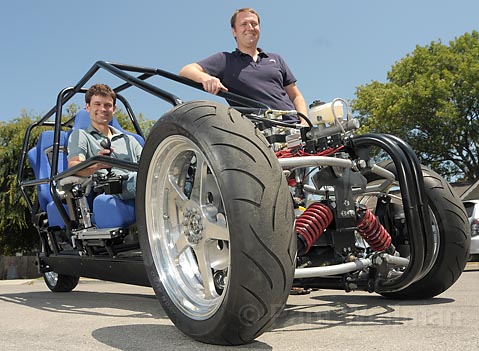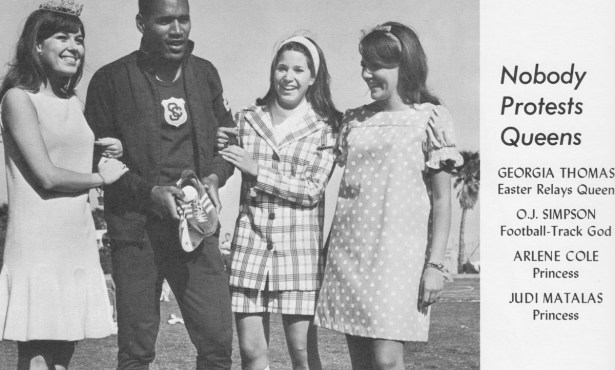The Dagne
A Sustainable Prototype from Goleta

As I drove up to Eric Sandoz’s home in Goleta, I saw the naked prototype of what will eventually become the Dagne waiting for me in the driveway. The three-wheeled Dagne is an electric commuter car that can do 120 mph. In conceptual drawings, it looks like it arrived from the future. Sandoz and Ben Werner, the founders of Multimode Technologies in Goleta, are creating the Dagne to rescue us all from unpleasant traffic conditions, horrifying gas prices, and a rapidly depleting planet.
Just before I got to his house, Werner was physically pushing Sandoz, who was sitting in the driver’s seat, down the street in the prototype to test out the braking and steering. The Dagne is still in the “mule” phase, meaning that her mechanical parts are still being tested. But Werner and Sandoz recently gave the Dagne her first successful test drive. They are now hoping for investors to contribute the next $1.8 million they will require to launch the next prototype.
The Dagne’s prototype design, while futuristic, still somehow manages to resemble a go-cart, but that will change when the car has its doors and windows added. A joystick, reminiscent of a video game controller, controls the Dagne’s steering and braking. “The joystick is more intuitive than the wheel of a regular car,” Werner said.
Due to the simplicity of its electric drive system, the Dagne can sell for less than $20,000, and it can run as either a pure electric vehicle or as a hybrid. Four gallons of gas or biodiesel would pull about 600 miles. It will require little of the usual car maintenance. There are a few competitors who also have three-wheeled electric car prototypes, but none is expected to be as inexpensive as the Dagne. One of them, the Tango, is being priced at around $108,000.
The Dagne is named after the heroine in Ayn Rand’s Atlas Shrugged. Rand’s protagonist, whose name translates from Scandinavian as “new day,” is on a quest that resonates with Werner and Sandoz. The character struggles to reconcile personal self-interest with the greater good of the community and discovers that a path exists for each of us that serves both.
When I asked if they were concerned about intervention from big car manufacturers, Sandoz teasingly asked me, “You’ve seen Who Killed the Electric Car? haven’t you?” Guilty as charged. Chris Paine’s 2006 documentary explores the role of automobile manufacturers, the oil industry, and the U.S. government in the limiting and sabotaging of electric vehicle technology. Werner responded, “If anything, there has been a huge backlash against the big car companies because of the way they killed the electric car in the ’90s.”
He said that, in light of the tidal wave of environmental awareness that has risen in the last few years, “There is a feverish desire for a vehicle that is sustainable and doesn’t require people to pay $4 a gallon for gas.”
“Sustainability should be fun,” in Werner’s opinion, but that does not mean the Dagne is a toy: It’s designed to be a seriously freeway-worthy automobile. Werner, who has a masters degree in electrical engineering from UCSB, even hopes that people “will want to replace the family car with the Dagne.” A two-seater seems a bit small if the family’s made of more than two, even with the trunk that Werner and Sandoz plan to install for groceries, soccer balls, and the various other things families carry around.
It’s easy to imagine using the Dagne for errands, commuting, or even road trips, but wouldn’t a three-wheeled vehicle roll over more easily than a four-wheeler? “Every vehicle can roll over,” Werner said, pointing to the regular rollovers of 16-wheeled diesel rigs. “But you would be less likely to roll over in the Dagne than in a sports car.”
His reasoning for such a statement is the Dagne can hold turns much easier than a sports car due to the aerodynamic design of the body, which banks into the curves-similar to a motorcycle, except that the Dagne’s lean is computer-controlled, and its driver will not need a motorcycle license to drive this baby (a typical Class C driver’s license will suffice). The fact that two of its wheels are in the front rather than the back helps make the Dagne more stable than other three-wheeled electric cars, Sandoz said. The Dagne has safety features similar to those employed in racecars, such as advanced seatbelts and airbags.
Sandoz and Werner’s goal is to have a completed product ready for mass production by 2011, which is none too soon for people excitedly anticipating a takeover by electric cars and hybrids to replace the gas-guzzling monsters we have to share the lanes with now. They hope that the Santa Barbara community will embrace the Dagne and sustainable living. “It’s the next hottest thing,” said Sandoz.



